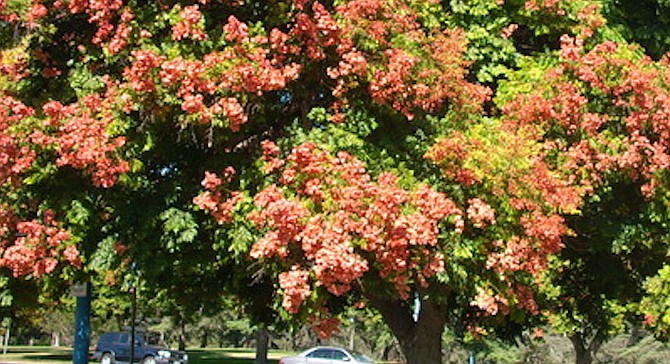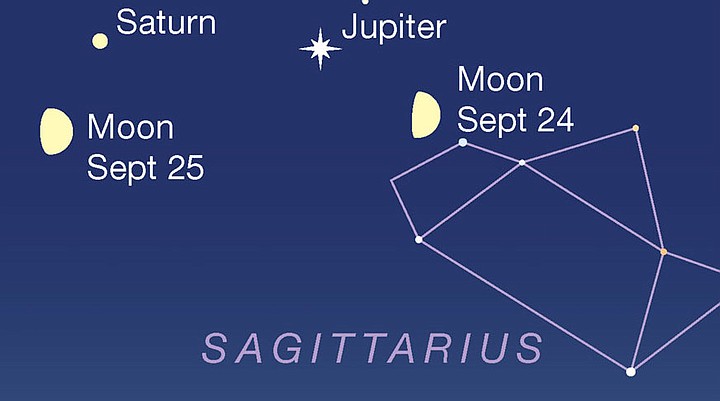 Facebook
Facebook
 X
X
 Instagram
Instagram
 TikTok
TikTok
 Youtube
Youtube

Fall Officially Begins on Tuesday, September 22 — possibly good enough to throw a premature, after-work celebratory party. The event is also known as the “autumnal equinox.” Technically, this means that at that on this day the sun will be shining directly down somewhere on the Earth’s equator — in this particular case, near Christmas Island in the mid-Pacific Ocean. The autumn season will continue for three months until the sun “moves” to its farthest southerly point, winter solstice, December 21.
Equal Days and Nights everywhere on Earth, 12 hours each, are only one noticeable consequence during the time of equinox, either autumnal or vernal (spring). Another consequence is that the sun at equinox always rises from a point on the horizon due east and later sets due west. You could calibrate a compass this way if you had access to a true (unobstructed) horizon. Another very subtle consequence is that at mid-latitudes like ours, morning and evening twilight periods are shortest during equinox. From San Diego, the duration of twilight this week is about 80 minutes; last June it was about 100 minutes.
The Smoggiest Days of the Year are most likely to occur during the next two or three months. Persistent temperature inversions (warmer air overlying cool marine air) are frequent this time of year. These inversions conspire with the mountainous topography of East County to trap locally generated air pollution under a low-lying lid. During the worst episodes, San Diego County’s coastal area is the hapless recipient of additional smog sneaking down from the Los Angeles Basin. This often occurs when a Santa Ana wind condition begins to weaken: L.A. smog blown offshore by a Santa Ana may get pushed back our way when the normal sea breeze returns.

Chinese flame trees are starting to display colorful clusters of orange, reddish, or salmon-pink seed pods. Good specimens line the south end of Balboa Drive in Balboa Park, and Lake Murray Boulevard through San Diego’s San Carlos district. Most of the remainder of San Diego’s ornamental trees will continue to remain drab until November, the onset of “autumn” botanically.

Saturn and Jupiter near the moon. On Wednesday September 23 there will be a first-quarter moon (exact at 9:55 p.m. EDT). The moon shines in the south at dusk. To its left are Jupiter and Saturn, pointing at it. On Thursday, September 24, the Moon, a day past first quarter, shines just a few degrees from Jupiter. Saturn looks on from their left
The above comes from the Outdoors listings in the Reader compiled by Jerry Schad, author of Afoot & Afield in San Diego County. Schad died in 2011. Planet information from SkyandTelescope.org.


Fall Officially Begins on Tuesday, September 22 — possibly good enough to throw a premature, after-work celebratory party. The event is also known as the “autumnal equinox.” Technically, this means that at that on this day the sun will be shining directly down somewhere on the Earth’s equator — in this particular case, near Christmas Island in the mid-Pacific Ocean. The autumn season will continue for three months until the sun “moves” to its farthest southerly point, winter solstice, December 21.
Equal Days and Nights everywhere on Earth, 12 hours each, are only one noticeable consequence during the time of equinox, either autumnal or vernal (spring). Another consequence is that the sun at equinox always rises from a point on the horizon due east and later sets due west. You could calibrate a compass this way if you had access to a true (unobstructed) horizon. Another very subtle consequence is that at mid-latitudes like ours, morning and evening twilight periods are shortest during equinox. From San Diego, the duration of twilight this week is about 80 minutes; last June it was about 100 minutes.
The Smoggiest Days of the Year are most likely to occur during the next two or three months. Persistent temperature inversions (warmer air overlying cool marine air) are frequent this time of year. These inversions conspire with the mountainous topography of East County to trap locally generated air pollution under a low-lying lid. During the worst episodes, San Diego County’s coastal area is the hapless recipient of additional smog sneaking down from the Los Angeles Basin. This often occurs when a Santa Ana wind condition begins to weaken: L.A. smog blown offshore by a Santa Ana may get pushed back our way when the normal sea breeze returns.

Chinese flame trees are starting to display colorful clusters of orange, reddish, or salmon-pink seed pods. Good specimens line the south end of Balboa Drive in Balboa Park, and Lake Murray Boulevard through San Diego’s San Carlos district. Most of the remainder of San Diego’s ornamental trees will continue to remain drab until November, the onset of “autumn” botanically.

Saturn and Jupiter near the moon. On Wednesday September 23 there will be a first-quarter moon (exact at 9:55 p.m. EDT). The moon shines in the south at dusk. To its left are Jupiter and Saturn, pointing at it. On Thursday, September 24, the Moon, a day past first quarter, shines just a few degrees from Jupiter. Saturn looks on from their left
The above comes from the Outdoors listings in the Reader compiled by Jerry Schad, author of Afoot & Afield in San Diego County. Schad died in 2011. Planet information from SkyandTelescope.org.
Comments